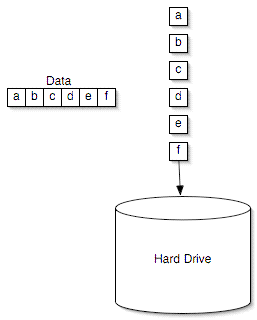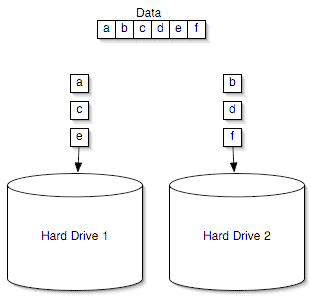Western Digital's Raptors in RAID-0: Are two drives better than one?
by Anand Lal Shimpi on July 1, 2004 12:00 PM EST- Posted in
- Storage
Doubling Theoretical Performance: RAID-0
For those of you who are already familiar with RAID and how it works, go ahead and skip to the benchmarks; these next two pages are designed to serve as brief introductions to the two most common forms of RAID on the desktop: RAID-0 and RAID-1.Otherwise known as striping, RAID-0 is the only performance-enhancing form of RAID that we'll be talking about in this article. The premise behind striping is simple. Data being written to a drive is split into "stripes", generally 16 - 256KB in size, with each stripe being written to a different drive in the array. For example, say we were dealing with a 2-drive RAID-0 array with a stripe size of 128KB and we wanted to write 256KB of data; drive 0 would get the first 128KB of data written to it, and drive 1 would get the remaining 128KB.

Writing to a single hard disk

Writing to a two-disk RAID-0 array
Here, you can see that the write performance of RAID-0 can be almost double that of a single drive, since twice as much data gets written at the same time. The higher write performance is obtained at the expense of some controller overhead, since the RAID controller has to handle splitting up data into stripes before sending it to the drives themselves - but with modern day microprocessors being as fast as they are, the overhead is usually thought of as negligible.
Reading works the exact same way, but in reverse. Say that we want to read that same 256KB of data back; we pull one stripe from drive 0 and the other stripe from drive 1. The read is now completed in half the time, theoretically doubling performance.
We are careful to use the word "theoretical" because the performance advantages of RAID-0 disappear quickly if we're not dealing in ideal situations like the ones we just described. If too large of a stripe size is used, then the performance advantages of RAID-0 can be lost, while too small of a stripe size could result in excess overhead, reducing the performance improvement of the striped array.
We have seen in the past that for most desktop applications, the largest stripe size that a desktop RAID controller will offer is usually the best choice for performance. With Intel's ICH5/6, that translates into a 128KB stripe size, which for our comparison is what we decided to go with. The other stripe size options didn't offer any better performance for our desktop test suite.
The main downside to RAID-0, other than cost, is reliability. The size of a RAID-0 array is the sum of all of its members; so, two 100GB drives in a RAID-0 array will give you one array with a 200GB total capacity. Unfortunately, if you lose any one of the drives in the array, all of your data is lost and isn't recoverable. Since two drives are working in tandem and are both necessary to hold your data, you effectively halve the mean time between failure by moving to a two-drive RAID-0 array.










127 Comments
View All Comments
Pariah - Friday, July 2, 2004 - link
If you look way back at comment #37 you will see my last paragraph is basically exactly what you said in your last paragraph. I agree completely that the article stunk, and that basically all the storage related articles on this site throughout its history have stunk. I just think that your nitpicking of his usage of the word RAID in the conclusion was one of the least important problems in the article, as anyone with half a brain knew what he was talking about when he said that, regardless of whether it was a valid point or not.Denial - Friday, July 2, 2004 - link
As you can see by what i wrote above, I agree with you. What he meant and what he said are different things though. The fact that he left out too much of the systems configuration in order for us to see if it was configured properly means that the test cannot be replicated and is therfore useless. Whatever you think regarding IDE RAID 0, which I have no experience with, you cannot dispute the fact that leaving out critical configuration settings is a no-no for a review such as this. When he runs those gaming tests for one of those new overpriced video cards, he invludes quite a bit more details in the review, yes? Suppose he didn't say what resolution the game was run at, AA on or off, filtering level, etc. Would you be able to verify his results? No.Why does he spend so much time and put so much detail into a review for items as "important" as a 3d card, then completely blow it on this review? I don't have an answer to that, do you? My assumption is that he is not well versed in modern storage technologies and how the file system and many other details play a major role in overall performance, in which case he should have had somebody else perform the tests and write the article, as he does with many of the other articles on the site.
Pariah - Friday, July 2, 2004 - link
Denial, you need some help in determining "target audience." 99% of home users using RAID or thinking about it are likely thinkinb about a 2 drive RAID 0 array. Those 99% of users are who this article is targetted at. And when he says RAID in his conclusion, the setup he tested (2 drive RAID 0), is what he means.If you are thinking about going with something more complicated/advanced, then this article was NOT for you.
Denial - Friday, July 2, 2004 - link
#50, did you not read the article?"If you haven't gotten the hint by now, we'll spell it out for you: there is no place, and no need for a RAID-0 array on a desktop computer. The real world performance increases are negligible at best and the reduction in reliability, thanks to a halving of the mean time between failure, makes RAID-0 far from worth it on the desktop."
This statement is so far fetched it is rediculous. This might be applicable to Raptors on an Intel onboard garbage RAID controller, but the above is a general statement. Maybe if it was changed to
"If you haven't gotten the hint by now, we'll spell it out for you: there is no place, and no need for an ATA RAID-0 array on a desktop computer using an Intel onboard RAID controller."
Written this way his conclusion might be correct, but the way he wrote, it's flat out WRONG.
Pariah - Thursday, July 1, 2004 - link
#48, your post was even more worthless than Anand's article. At least Anand's article had a setup that was remotely applicable to what a user he was targetting with the article would have.Despite what numerous people seem to think in the comments, for a 2 drive ATA RAID 0 array, the controller you use is about as irrelevant an issue as there is. $500 card, free onboard, hardware, software, me using a piece of notebook paper and crayons to calculate drive assignments for data will not make any noteworthy difference in performance.
Denial - Thursday, July 1, 2004 - link
The above comments about stripe size are true as well. Depending on the app, a 64k array stripe matched with a 64k stripe in NTFS will produce much different results that the default 4k(?) that windoze uses on NTFS partitions. We're talking a HUGE *HUGE* **HUGE** difference in performance here. HUGE!!!! I've never used one of those onboard raid solutions, do they even allow the option of setting the stripe size? I'd wouldn't be surprised if they didn't which would make this review even that much more useless.Denial - Thursday, July 1, 2004 - link
What kind of scientific testing was this? ALL RAID 0 is useless because an Intel onboard RAID solution sucks? Why did Anand waste his time on this?I can tell you for a fact that my 8 disk RAID 10 array, with 15k 73GB Cheetahs, running on a LSI 320-2, installed in a 133MHZ PCI-X slot on my dual Xeon 7505 motherboard (Vero) is just a *tad* faster than a single drive setup. ;)
Anand must be on crack making a blanket statement like that. Is this the best he can gve us after a few years of college? What a sorry article.
Zebo - Thursday, July 1, 2004 - link
#1 that's called placebo effect! Same goes for any other "feels" faster hardware such as the A64. The user spent the money, expecting a return, and it gave a false positive.I have been droning on about how raid 0 is worthless waste of money since I read this:
http://faq.storagereview.com/tiki-index.php?page=S...
And thanks to anands wonderful work we have coorberation.
TrogdorJW - Thursday, July 1, 2004 - link
As others are stating, RAID 1 on any *decent* RAID controller should have faster read rates. www.StorageReview.com has shown this in a recent article. So the statement "We won't be benchmarking RAID-1 here because, for the most part, there's no performance increase or decrease" while true in part (you didn't perform the benchmarks), was a bad decision, as performance should differ from a single drive. Of course, for single-user usage, RAID 1 would be even less useful than RAID 0 - except for adding redundancy.MajorKong - Thursday, July 1, 2004 - link
It's a shame that a RAID 1 array with the same Raptor II (and 7200 RPM drives) wasn't benchmarked. The read performance of RAID 1 can be as good as that of RAID 0 on a good controller. The only case where that's not true is if a lot of writing, which is slower than either RAID 0 or a single disk is being done to the array while reads are in progress.